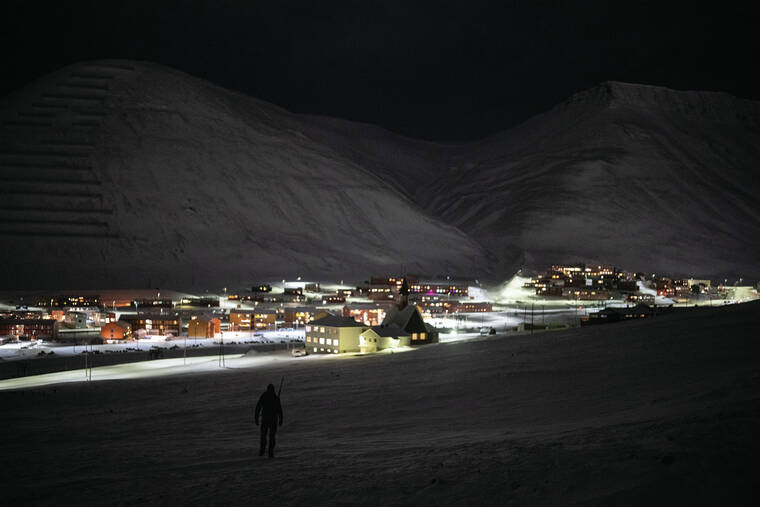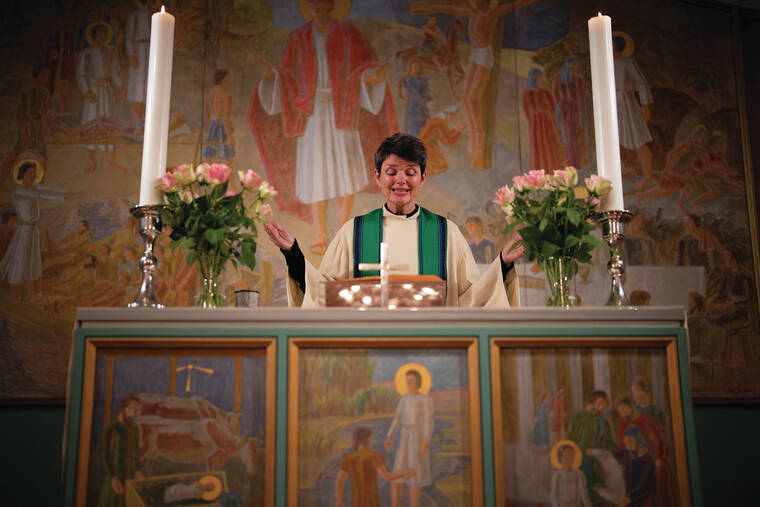Church helps mining community evolve in dark, warming Arctic
LONGYEARBYEN, Norway — The warm glow of Svalbard Kirke’s lights gleams on the mountain slope from where the church stands over this remote Norwegian Arctic village, cloaked in the polar night’s constant darkness.
A century after it was founded to minister to the coal miners who settled Longyearbyen, the Lutheran house of faith is open 24/7, serving as a beacon for the community navigating a drastic change in its identity.
ADVERTISING
The last Norwegian coal mine in Svalbard – an archipelago that’s one of the world’s fastest warming spots – was slated to close this year and only got a reprieve until 2025 because of the energy crisis driven by the war in Ukraine.
For the lone pastor, the challenge is to fulfill the church’s historical mission of ministering to those in crisis while addressing a pressing, divisive contemporary challenge.
“We pray every Sunday for everyone who’s affected by climate change,” the Rev. Siv Limstrand said.
Svalbard Kirke beckons to its fireplace-warmed lounge that opens into the sanctuary. A cup of coffee or hymnbooks in multiple languages are always available.
“You don’t have to be very religious. They have room for everybody,” said Leonard Snoeks, whose daughter sings in Polargospel, the church’s children’s choir, and whose wife is working on the city’s energy plan.
The switch this year from coal-fired to diesel-powered energy production at the plant – which prompted the mine’s decision to shut down – is expected to halve carbon dioxide emissions, said Torbjørn Grøtte, Longyearbyen’s energy transition project leader.
As change swirls faster than the snowdrifts outside, the church’s anchoring role seems poised to remain the only constant.
It attracts miners who have attended funerals for colleagues who died on the job over the decades, as well as newly arrived scientists and tourism workers seeking to integrate in the increasingly diverse community where people now tend to stay only a couple of years.
Store Norske, the Norwegian company still operating the remaining mine, built the first church in 1921 in Longyearbyen, which for most of the 20th century was inhabited by single miners and the mining executives’ families.
Trond Johansen was 17 when he arrived in 1971 on a plane chartered by the mining company. Sipping black coffee on a mid-January morning in the town’s sleek café, the retired miner recalled when the main entertainment was at the church.
Johansen and fellow miners gathered on Wednesdays to watch four-week-old videocassettes of news broadcasts from the mainland – though they skipped the weather forecast, Johansen added with a chuckle.
“It was a fantastic place to grow up, more free probably than many places, and you had the wild and the excitement with polar bears lurking around,” said Bent Jakobsen, who was born on Svalbard and works at the coal mine like his father and brothers before him.
But today he jokes the mine’s closing will turn him into an endangered species just like the iconic Arctic predator.
“I can be stuffed and put in the museum, me and the polar bear,” Jakobsen said.
Svalbard’s natural environment has been changing fast, too. There’s no more ice on Isfjorden, which translates as “ice fjord” and whose feet-thick ice cover used to be traversed by polar bears in winter until a dozen years ago.
“Everything except the darkness has changed,” said Kim Holmén, special advisor to the Norwegian Polar Institute.
Swept by the Gulf Stream ocean current, and with growing open water that accelerates the warming, Svalbard is heating up even faster than the rest of the Arctic.
Unusual winter rains unsettle the snowpack, leading to more avalanches, including a deadly one around Christmas in 2015 that killing two people in Longyearbyen.



